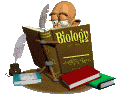| Chapter
Objectives
- Distinguish
among herbivores, carnivores, and omnivores
- Describe
the following feeding mechanisms and give examples of animals
that use each
- filter-feeding
- deposit-feeding
- substrate-feeding
- fluid-feeding
- Define
digestion and describe why it is a necessary process
- Explain
how anhydro bonds are formed and describe the role of hydrolysis
in digestion
- Distinguish
between intracellular and extracellular digestion
- Explain
why intracellular digestion must be sequestered in a food
vacuole and give examples of organisms which digest their
food in vacuoles
- Define
gastrovascular cavity and explain why extracellular digestive
cavities are advantageous
- Using
Hydra as an example, describe how a gastrovascular
cavity functions in both digestion and distribution of nutrients
- List
major animal phyla which use gastrovascular cavities for digestion
- Describe
advantages that complete digestive tracts have over gastrovascular
cavities and list the major animal phyla with alimentary tracts
- Define
peristalsis and describe its role in the digestive tract
- Describe
how salivation is controlled and list the functions of saliva
- Describe
the role of salivary amylase in digestion
- Describe
the sequence of events which occur as a result of the swallowing
reflex
- Describe
the function of the esophagus and explain how peristalsis
in the esophagus is controlled
- Describe
the role of cardiac and pyloric sphincters
- List
the 3 types of secretory cells found in stomach epithelium
and what substances they secrete
- Recall
the normal pH of the stomach and explain the function of stomach
acid
- Describe
the function of pepsin
- Explain
why the stomach normally does not digest itself
- Explain
how pepsin and acid secretion are regulated and describe the
roles of the hormones gastrin and enterogastrone
- Describe
the cause of ulcers and explain why they are frequently found
in the duodenum
- Explain
how chyme is moved through the small intestine
- Describe
the sequence of events which occur in response to acid chyme
entering the duodenum. Include the roles of
- secretin
- bicarbonate
- cholecystokinin
(CCK)
- gall
bladder
- bile
- pancreatic
enzymes
- enterogastrone
- Describe
how pancreatic zymogens for proteolytic enzymes are activated
in the duodenum and include the role of the intestinal enzyme
enterokinase
- Describe
enzymatic digestion of carbohydrates, proteins, lipids, and
nucleic acids, including the reactants and products for each
enzymatic reaction and whether they occur in the
- oral
cavity
- stomach
- lumen
of small intestine
- brush
border of small intestine
- Explain
the function of bile, describe where it is produced and stored,
and describe its composition
- State
whether the lumen of the digestive tract is technically inside
or outside the body
- Explain
where nutrient absorption occurs
- Explain
why the many folds, villi, and microvilli are important in
the small intestine
- Describe
how specific nutrients are absorbed across the intestinal
epithelium and across the capillary or lacteal wall and indicate
whether the transport is with or against the concentration
gradient
- Explain
what happens to glycerol and fatty acids after they are absorbed
into the intestinal epithelium and describe the fate of chylomicrons
and lipoproteins
- Explain
the function of the hepatic portal vein
- Explain
where in the digestive tract the most reabsorption of water
occurs
- Describe
the composition of feces and explain the main source of vitamin
K for humans
- Give
examples of vertebrates with the following digestive adaptations
and explain how these adaptations are related to diet
- variation
in dentition
- variation
in length of digestive tract
- fermentation
chambers
- Explain
why animals need a nutritionally adequate diet
- Describe
the effects of undernourishment or starvation
- List
some risks of obesity
- Distinguish
between malnourished and undernourished
- List
4 classes of essential nutrients and describe what happens
if they are deficient in the diet
- List
and distinguish between water-soluble and fat-soluble vitamins
and explain how they are used by the body
- Describe
the dietary sources, major body functions, and deficiency
effects for the following required minerals in the human diet
- calcium
- phosphorus
- sulfur
- potassium
- chlorine
- sodium
- magnesium
- iron
|
| Chapter
Terms:
| undernourished
essential nutrients
malnourished
essential amino acids
essential fatty acids
vitamins
minerals
herbivores
carnivores
omnivores
ingestion
digestion
enzymatic hydrolysis
absorption
elimination
suspension-feeders
substrate-feeders
deposit-feeders
fluid-feeders
bulk-feeders
intracellular digestion
extracellular digestion
gastrovascular cavity
complete digestive
tract
alimentary canal |
peristalsis
sphincters
salivary gland
pancreas
liver
gall bladder
oral cavity
salivary amylase
bolus
pharynx
epiglottis
esophagus
stomach
gastric juice
pepsin
pepsinogen
acid chyme
pyloric sphincter
small intestine
duodenum
bile
trypsin
chymotrypsin
carboxypeptidase
aminopeptidase |
dipeptidase
enteropeptidase
nucleases
emulsification
lipase
jejunum
ileum
villi
microvilli
brush border
lacteal
chylomicrons
hepatic portal vein
gastrin
secretin
cholecystokinin (CCK)
enterogastrone
large intestine
colon
cecum
appendix
feces
rectum
ruminant
anus |
|
| Chapter
Outline Framework
- Nutritional
Requirements
- Animals
are heterotrophs that require food for fuel, carbon skeletons,
and essential nutrients
- Homeostatic
mechanisms manage an animal's fuel
- An
animal's diet must supply essential nutrients and carbon
skeletons for biosynthesis
- Food
Types Feeding Mechanisms
- Most
animals are opportunistic feeders
- Diverse
feeding adaptations have evolved among animals
- Overview
of Food Processing
- 4 main
stages of food processing
- ingestion
- digestion
- absorption
- elimination
- Digestion
occurs in specialized compartments
- Mammalian
Digestive System
- Oral
cavity, pharynx, and esophagus initiate food processing
- Stomach
stores food and performs preliminary digestion
- Small
intestine is major organ of digestion and absorption
- Hormones
help regulate digestion
- Reclaiming
water is major function of large intestine
- Evolutionary
Adaptations of Vertebrate Digestive System
- Structural
adaptations of digestive system often associated with diet
- Symbiotic
organisms help nourish many vertebrates
back
to top |
|

